- Cambridge Dictionary +Plus

Reported speech: indirect speech
Indirect speech focuses more on the content of what someone said rather than their exact words. In indirect speech , the structure of the reported clause depends on whether the speaker is reporting a statement, a question or a command.
Indirect speech: reporting statements
Indirect reports of statements consist of a reporting clause and a that -clause. We often omit that , especially in informal situations:
The pilot commented that the weather had been extremely bad as the plane came in to land. (The pilot’s words were: ‘The weather was extremely bad as the plane came in to land.’ )
I told my wife I didn’t want a party on my 50th birthday. ( that -clause without that ) (or I told my wife that I didn’t want a party on my 50th birthday .)
Indirect speech: reporting questions
Reporting yes-no questions and alternative questions.
Indirect reports of yes-no questions and questions with or consist of a reporting clause and a reported clause introduced by if or whether . If is more common than whether . The reported clause is in statement form (subject + verb), not question form:
She asked if [S] [V] I was Scottish. (original yes-no question: ‘Are you Scottish?’ )
The waiter asked whether [S] we [V] wanted a table near the window. (original yes-no question: ‘Do you want a table near the window? )
He asked me if [S] [V] I had come by train or by bus. (original alternative question: ‘Did you come by train or by bus?’ )
Questions: yes-no questions ( Are you feeling cold? )
Reporting wh -questions
Indirect reports of wh -questions consist of a reporting clause, and a reported clause beginning with a wh -word ( who, what, when, where, why, how ). We don’t use a question mark:
He asked me what I wanted.
Not: He asked me what I wanted?
The reported clause is in statement form (subject + verb), not question form:
She wanted to know who [S] we [V] had invited to the party.
Not: … who had we invited …
Who , whom and what
In indirect questions with who, whom and what , the wh- word may be the subject or the object of the reported clause:
I asked them who came to meet them at the airport. ( who is the subject of came ; original question: ‘Who came to meet you at the airport?’ )
He wondered what the repairs would cost. ( what is the object of cost ; original question: ‘What will the repairs cost?’ )
She asked us what [S] we [V] were doing . (original question: ‘What are you doing?’ )
Not: She asked us what were we doing?
When , where , why and how
We also use statement word order (subject + verb) with when , where, why and how :
I asked her when [S] it [V] had happened (original question: ‘When did it happen?’ ).
Not: I asked her when had it happened?
I asked her where [S] the bus station [V] was . (original question: ‘Where is the bus station?’ )
Not: I asked her where was the bus station?
The teacher asked them how [S] they [V] wanted to do the activity . (original question: ‘How do you want to do the activity?’ )
Not: The teacher asked them how did they want to do the activity?
Questions: wh- questions
Indirect speech: reporting commands
Indirect reports of commands consist of a reporting clause, and a reported clause beginning with a to -infinitive:
The General ordered the troops to advance . (original command: ‘Advance!’ )
The chairperson told him to sit down and to stop interrupting . (original command: ‘Sit down and stop interrupting!’ )
We also use a to -infinitive clause in indirect reports with other verbs that mean wanting or getting people to do something, for example, advise, encourage, warn :
They advised me to wait till the following day. (original statement: ‘You should wait till the following day.’ )
The guard warned us not to enter the area. (original statement: ‘You must not enter the area.’ )
Verbs followed by a to -infinitive
Indirect speech: present simple reporting verb
We can use the reporting verb in the present simple in indirect speech if the original words are still true or relevant at the time of reporting, or if the report is of something someone often says or repeats:
Sheila says they’re closing the motorway tomorrow for repairs.
Henry tells me he’s thinking of getting married next year.
Rupert says dogs shouldn’t be allowed on the beach. (Rupert probably often repeats this statement.)
Newspaper headlines
We often use the present simple in newspaper headlines. It makes the reported speech more dramatic:
JUDGE TELLS REPORTER TO LEAVE COURTROOM
PRIME MINISTER SAYS FAMILIES ARE TOP PRIORITY IN TAX REFORM
Present simple ( I work )
Reported speech
Reported speech: direct speech
Indirect speech: past continuous reporting verb
In indirect speech, we can use the past continuous form of the reporting verb (usually say or tell ). This happens mostly in conversation, when the speaker wants to focus on the content of the report, usually because it is interesting news or important information, or because it is a new topic in the conversation:
Rory was telling me the big cinema in James Street is going to close down. Is that true?
Alex was saying that book sales have gone up a lot this year thanks to the Internet.
‘Backshift’ refers to the changes we make to the original verbs in indirect speech because time has passed between the moment of speaking and the time of the report.
In these examples, the present ( am ) has become the past ( was ), the future ( will ) has become the future-in-the-past ( would ) and the past ( happened ) has become the past perfect ( had happened ). The tenses have ‘shifted’ or ‘moved back’ in time.
The past perfect does not shift back; it stays the same:
Modal verbs
Some, but not all, modal verbs ‘shift back’ in time and change in indirect speech.
We can use a perfect form with have + - ed form after modal verbs, especially where the report looks back to a hypothetical event in the past:
He said the noise might have been the postman delivering letters. (original statement: ‘The noise might be the postman delivering letters.’ )
He said he would have helped us if we’d needed a volunteer. (original statement: ‘I’ll help you if you need a volunteer’ or ‘I’d help you if you needed a volunteer.’ )
Used to and ought to do not change in indirect speech:
She said she used to live in Oxford. (original statement: ‘I used to live in Oxford.’ )
The guard warned us that we ought to leave immediately. (original statement: ‘You ought to leave immediately.’ )
No backshift
We don’t need to change the tense in indirect speech if what a person said is still true or relevant or has not happened yet. This often happens when someone talks about the future, or when someone uses the present simple, present continuous or present perfect in their original words:
He told me his brother works for an Italian company. (It is still true that his brother works for an Italian company.)
She said she ’s getting married next year. (For the speakers, the time at the moment of speaking is ‘this year’.)
He said he ’s finished painting the door. (He probably said it just a short time ago.)
She promised she ’ll help us. (The promise applies to the future.)
Indirect speech: changes to pronouns
Changes to personal pronouns in indirect reports depend on whether the person reporting the speech and the person(s) who said the original words are the same or different.
Indirect speech: changes to adverbs and demonstratives
We often change demonstratives ( this, that ) and adverbs of time and place ( now, here, today , etc.) because indirect speech happens at a later time than the original speech, and perhaps in a different place.
Typical changes to demonstratives, adverbs and adverbial expressions
Indirect speech: typical errors.
The word order in indirect reports of wh- questions is the same as statement word order (subject + verb), not question word order:
She always asks me where [S] [V] I am going .
Not: She always asks me where am I going .
We don’t use a question mark when reporting wh- questions:
I asked him what he was doing.
Not: I asked him what he was doing?

Word of the Day
box someone in
Your browser doesn't support HTML5 audio
to move so close to someone or something that the person or thing cannot move away

It’s written in the stars: talking about things that might happen in the future

Learn more with +Plus
- Recent and Recommended {{#preferredDictionaries}} {{name}} {{/preferredDictionaries}}
- Definitions Clear explanations of natural written and spoken English English Learner’s Dictionary Essential British English Essential American English
- Grammar and thesaurus Usage explanations of natural written and spoken English Grammar Thesaurus
- Pronunciation British and American pronunciations with audio English Pronunciation
- English–Chinese (Simplified) Chinese (Simplified)–English
- English–Chinese (Traditional) Chinese (Traditional)–English
- English–Dutch Dutch–English
- English–French French–English
- English–German German–English
- English–Indonesian Indonesian–English
- English–Italian Italian–English
- English–Japanese Japanese–English
- English–Norwegian Norwegian–English
- English–Polish Polish–English
- English–Portuguese Portuguese–English
- English–Spanish Spanish–English
- English–Swedish Swedish–English
- Dictionary +Plus Word Lists
To add ${headword} to a word list please sign up or log in.
Add ${headword} to one of your lists below, or create a new one.
{{message}}
Something went wrong.
There was a problem sending your report.

Ronald Kaunda
Reported Speech: A Comprehensive Guide with Clear Examples
Learn the rules and intricacies of reported speech with our detailed guide. Understand how to convert direct speech into indirect speech, master tense changes, and explore examples of reported questions, commands, and modal verbs. Perfect for students and educators alike!
Reported speech is the way we communicate what someone else has said. It allows us to convey information from other speakers, either by using their precise wording (Direct Speech) or by modifying it to suit our context (Indirect Speech).
Understanding the difference between direct and indirect speech is essential for clear communication in both written and spoken language.
This guide will explore both forms, key rules for changing tenses, pronouns , and time expressions, and provide examples for reporting statements , questions, commands, and modal verbs .

Direct Speech
Direct Speech involves quoting the speaker’s exact words, enclosed in quotation marks. A reporting verb such as said , told , or asked introduces the speech. This method is typically used when we want to capture the speaker’s original tone, phrasing, or emotion.
Structure of Direct Speech:
- Subject + Reporting Verb + Quotation Marks (” “)
- The first letter inside the quotation marks is always capitalized.
- Mwansa said, “I didn’t find the house I was looking for in Mansa.”
- “I’m going to the cinema tonight,” John said.
- The teacher said, “You have done a great job in your assignments.”
In the above examples, the original words are preserved exactly, including tense and pronouns. This makes it useful for storytelling, dialogue, or quoting someone verbatim.
Shop laptop & School bags
Check out top-quality laptops and stylish school bags at Zed PCs – perfect for work, study, and on-the-go convenience! Shop now and find unbeatable deals on the essentials you need. For more information, don’t hesitate to get in touch with the website directly. Come one, come all.
Positions of Reporting Verbs in Direct Speech
In direct speech, reporting verbs such as say , ask , reply , shout , and explain indicate the action of speaking.
The placement of these verbs can vary, appearing at the beginning , middle , or end of the quoted text.
Each position affects the flow and rhythm of the sentence. Below is a detailed explanation of the three positions, along with more examples.
1. Beginning Position
The reporting verb introduces the quoted speech, establishing the context before the words are spoken. This position is formal and common in narrative writing.
- He said , “We need to leave early tomorrow.”
- She explained , “The project must be submitted by Friday.”
- The teacher asked , “Did you finish your homework?”
- They shouted , “Watch out for the car!”
This structure helps the reader or listener understand who is speaking before they focus on the actual words spoken.
2. Middle Position
The reporting verb appears between two parts of the speech, breaking the quote into two segments. This structure mimics natural dialogue, creating pauses and maintaining a conversational tone.
- “I think,” he said , “that we should go to the meeting.”
- “This is wonderful news,” she exclaimed , “and I can’t wait to share it with everyone.”
- “If you need help,” the teacher offered , “feel free to ask me.”
- “We can’t continue like this,” she added , “unless we get more support.”
Using this position can convey emotions like hesitation, excitement, or interruption, adding depth to the speech.
3. End Position
In this structure, the quoted speech comes first, followed by the reporting verb. This format is often used in brief dialogues to keep the focus on the words spoken. It is common in informal writing or when the speaker’s identity is already implied.
- “Let’s meet at 3 PM,” John suggested .
- “I don’t agree with that,” she replied .
- “I’m sorry for being late,” he apologized .
- “Are you coming with us?” they asked .
This position emphasizes the speech itself, with the reporting verb confirming who said it after the fact.
Indirect Speech
Indirect Speech is a way of reporting what someone said without quoting them directly. Instead of repeating the exact words, we convey the meaning by paraphrasing or rephrasing the original statement to fit the perspective of the new speaker.
This often involves changes to pronouns, verb tenses, and expressions of time or place to reflect the new context in which the speech is reported. Understanding these transformations is essential to accurately convey the speaker’s intended meaning in indirect speech.
Key Characteristics of Indirect Speech
No quotation marks are used.
Unlike direct speech, indirect speech does not use quotation marks. Instead, it embeds the reported statement within a sentence using a conjunction like “that” or phrases such as “if” or “whether” for reported questions.
- Direct Speech: Sarah said, “I am happy.”
- Indirect Speech: Sarah said that she was happy.
Tense Changes (Backshifting)
In most cases, the tense of the verbs in the original statement is shifted backwards (backshifting) to reflect that the speech occurred in the past. This ensures consistency between the time of speaking and the time of reporting.
- Present simple → Past simple “I work hard,” she said. → She said that she worked hard.
- Present continuous → Past continuous “I am studying,” he said. → He said that he was studying .
- Past simple → Past perfect “I visited Paris,” he said. → He said that he had visited Paris.
- Will → Would “I will call you,” she said. → She said that she would call me.
Exceptions: If the reported speech refers to a general truth or fact, the tense may not change.
“The sun rises in the east,” the teacher said. → The teacher said that the sun rises in the east.
Pronoun Change
Pronouns in indirect speech must be adjusted to fit the new speaker or subject’s point of view. The reporting speaker must alter first and second-person pronouns to third person (unless the new subject remains the same).
Therefore, pronouns change depending on the speaker and listener involved in the conversation. Below is an example to illustrate:
Direct: “I am happy to help you,” he said. Indirect: He said that he was happy to help me.
In the indirect version, I changes to he to reflect the new perspective, and you becomes me because the speech is now reported to a different person.
Time and Place Expressions
Time and place expressions often change to reflect the shift from the original moment of speech to the time of reporting. Here are common transformations:
- Now → Then “I am leaving now,” he said. → He said that he was leaving then .
- Today → That day “We will meet today,” she said. → She said that they would meet that day .
- Tomorrow → The next day / The following day “I will call you tomorrow,” he said. → He said that he would call me the next day .
- Yesterday → The day before / The previous day “I saw him yesterday,” she said. → She said that she had seen him the day before .
- Here → There “I am staying here,” he said. → He said that he was staying there .
- This → That “This is my favorite book,” she said. → She said that that was her favorite book.
Reporting Questions
When reporting questions, we need to follow these specific rules:
- The question format changes to a statement structure .
- We use if or whether to report yes/no questions .
- Wh- questions retain the question word but are converted into statements.
Reporting Yes/No Questions
When a yes/no question is reported, we introduce the reported speech with if or whether .
Examples: Direct: “Do you live in Lusaka?” he asked. Indirect: He asked if I lived in Lusaka.
Direct: “Can you help me with this problem?” he asked. Indirect: He asked if I could help him with that problem.
Reporting Wh- Questions
For wh- questions, we keep the question word (e.g., where , why , how ), but the sentence structure becomes declarative.
Examples: Direct: “Where are you going?” she asked. Indirect: She asked where I was going.
Direct: “Why did you miss the class?” the teacher asked. Indirect: The teacher asked why I had missed the class.
Reporting Imperatives and Requests
When reporting commands, orders, or requests , we typically use the verbs told or asked followed by the infinitive form of the verb.
Positive Imperatives
Examples: Direct: “Close the door!” she said. Indirect: She told me to close the door.
Direct: “Please help me with this task,” he said. Indirect: He asked me to help him with that task.
Negative Imperatives
For negative commands or requests, we use not before the infinitive.
Examples: Direct: “Don’t talk during the movie,” she said. Indirect: She told us not to talk during the movie.
Direct: “Don’t touch the exhibits,” the guide said. Indirect: The guide told us not to touch the exhibits.
Reporting Modal Verbs
When reporting sentences with modal verbs , some modals change, while others remain the same. Below are common changes:
Mastering reported speech requires a clear understanding of how to change tenses, pronouns, and time expressions to fit the context of the reporting.
Whether conveying statements, questions, commands, or requests, these adjustments ensure accurate communication of what was originally said.
By applying these rules, we can effectively relay information without ambiguity, maintaining both clarity and precision in our speech.
Hey! I am Ronald Kaunda, an educator and researcher. I like talking and writing about all things early literacy, language and African Indigenous knowledge systems as they relate to knowledge acquisition in and out of classroom contexts. I also enjoy writing about African/Zambian traditions as spaces for exploring Indigneous knowledge.
More like this

13 Essential English Punctuation Marks: What They Really Are, How to Use Them Effectively, and Examples
This is an essential guide to punctuation marks in English! Learn their meanings, uses, and see examples to improve clarity and structure in your writing. Master punctuation today!”
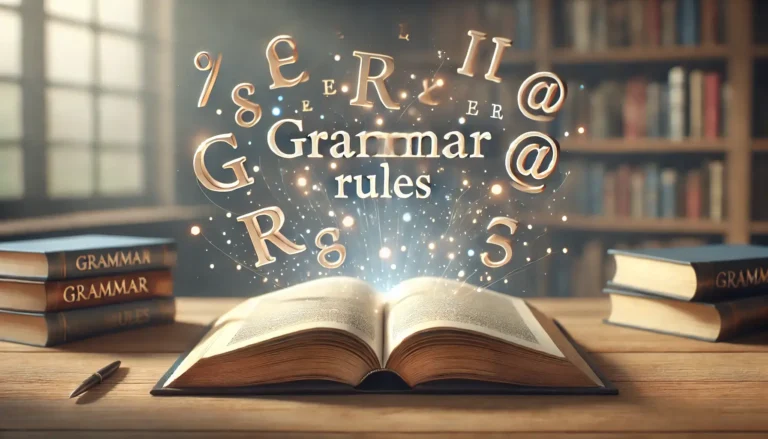
What is English Grammar? Master English Rules to Stop Sounding Unprofessional!
This article discusses English grammar and some rules that can transform one’s language skills overnight. It helps English language earners sound smarter, write better, and speak confidently.

Unreal Past: What is it, Use cases and Examples!
Discover the intricacies of the Unreal Past, a key concept in English grammar. Learn how to express wishes, regrets, and hypothetical scenarios using unreal time for effective and nuanced communication.

What are Intensifiers? Definitions and Examples (An Ultimate Guide)
Learn how to use intensifiers to add emphasis, emotion, and clarity to your language. Explore examples, tips, and best practices for enhancing your communication with impactful modifiers.

Quantifiers in English: The Ultimate Guide to Sound Fluent and Confident!
Learn how to use quantifiers effectively in English! This ultimate guide covers countable vs. uncountable nouns, formal vs. informal usage, and common mistakes to avoid.

Word Formation: Exploring 4 Prominent Processes Behind New Words in English
Learn word formation in English through affixation, compounding, conversion, and blending. Explore these dynamic word formation methods that shape and enrich the language.
Leave a Reply Cancel reply
Your email address will not be published. Required fields are marked *
Save my name, email, and website in this browser for the next time I comment.
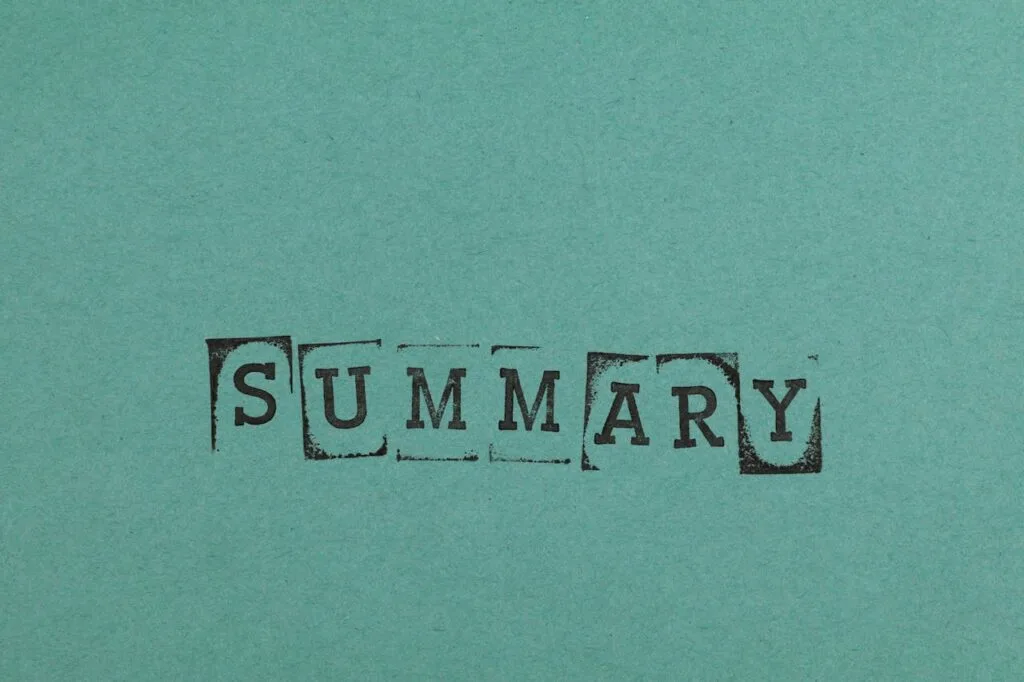
How to Write a Summary: 7 Steps for Writing a Good Summary

Speech Writing | Steps, Topics and Examples
© 2024 Ronald Kaunda. All Rights Researved.
Username or Email Address
Remember Me
Lost your password?
Don't have an account yet? Sign up

Direct and Indirect Speech Rules with Examples (Updated)

Understanding Direct and Indirect Speech Rules for conversion is crucial for effective communication. This updated guide explains the key rules, including how to choose the right reporting verbs, handle tense changes, and accurately convert speech. With clear examples and practical tips, it’s an ideal resource for students, ESL learners, and exam preparation.
Direct Speech
Direct speech is a form of reporting that presents someone’s exact words without any alterations. It is commonly enclosed in quotation marks.
Direct Speech Rules
Direct speech consists of the following elements.
- The speaker (subject)
- reporting verb
- object( to whom the speaker says something)
- reported speech
- Quotation marks
- Punctuation placement ( Commas , periods , question marks , and exclamation points )

Explanation: “I shall not go to school,” are the exact words of Riya, enclosed in quotation marks/inverted commas (“….”). This format, which uses commas and quotation marks/inverted commas, is called direct speech . In this sentence, ‘Riya’ is the subject or speaker, ‘says’ is the reporting verb, and ‘I shall not go to school’ is the reported speech.
For examples,
- Direct: “We can’t be quite happy in life,” he said .
- Direct: He said , “The Muslims bury their dead.”
- Direct: “ You’ve overcooked the steak again, Mary” , he said.
- Direct: Ramen said to Bina, “I’m going to your house this, week.”
- Direct: Ritu said, “I am going to the store.”
- Direct: “I can’t believe it,” she whispered, “but I saw a unicorn in the garden.”
People also ask
Indirect Speech
Indirect speech , on the other hand, involves paraphrasing someone’s words and reporting them indirectly, without using quotation marks. It requires a few changes in structure, such as tense and pronoun.
Indirect speech rules
- removing quotation marks
- changing pronouns
- adjusting tenses
- modifying time expressions
- making it into a statement
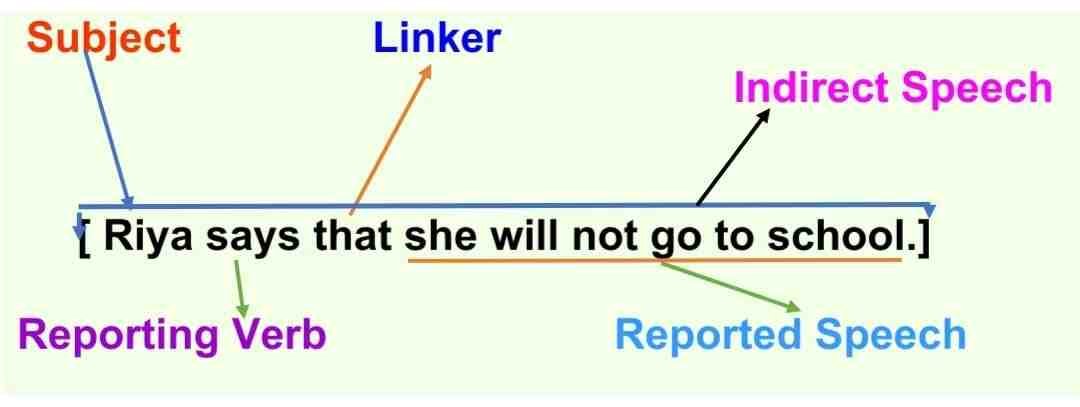
Similarly, we can report the above sentence without quoting Riya’s exact words while keeping the meaning the same. This format is called indirect speech. In this format, no commas or quotation marks/inverted commas are used; only a full stop (.) is used at the end of the sentence.
Direct Speech: “We can’t be quite happy in life,” he said. Indirect Speech: He said that they couldn’t be quite happy in life.
Direct Speech: He said, “The Muslims bury their dead.” Indirect Speech: He said that the Muslims bury their dead.
Direct Speech: “You’ve overcooked the steak again, Mary”, he said. Indirect Speech: He told Mary that she had overcooked the steak again.
Direct Speech: Ramen said to Bina, “I’m going to your house this, week.” Indirect Speech: Ramen told Bina that he was going to her house that week.
Direct Speech: John said, “I am going to the store.” Indirect Speech: John said that he was going to the store.
Direct Speech: “I can’t believe it,” she whispered, “but I saw a unicorn in the garden.” Indirect Speech: She whispered that she couldn’t believe it but that she had seen a unicorn in the garden.
Rules between direct and indirect speech
The following comparison highlights the key differences between direct and indirect speech rules, including punctuation, tense changes, and adjustments to pronouns and time references.
Direct and Indirect Speech Rules for Conversion in General
Discover the essential rules of direct and indirect speech with a variety of examples to improve your language skills. Effortlessly understand the intricacies of converting statements, questions, and commands from one form to another.
Rule 1: Direct and Indirect Speech Rules for Reporting verbs ‘ Say ‘ and ‘ Tell ‘.
“Say” and “tell” are two frequently used reporting verbs. “Say” is generally followed by the reported speech, while “tell” is followed by the indirect object (the person being addressed).
Direct: He says , “I am your friend.” Indirect: He says that he is your friend.
Direct: He said to me, “I’m going to the store.” Indirect: She told me that he was going to the store.
Reporting verbs ‘Say’ and ‘Tell’ Chart
Rule 2: direct and indirect speech rules for reporting verb, ‘ ask ‘ and ‘ inquire’.
When reporting questions , “ ask “ and “ inquire “ are commonly employed reporting verbs.
Direct: He said to me, “Where are you going?” Indirect: He asked where I was going.
Direct: She said , “When will the concert start?” Indirect: She inquired, “When will the concert start?”
Direct: Sarah said , “What time does the movie start?” Indirect: Sarah asked what time the movie started.
Direct: “Could you please provide more details?” she said to me. Indirect: She inquired politely if I could provide more details.
Direct: The customer said , “Do you have this item in stock?” Indirect: The customer i nquired if that item had in stock.
Rule 3: Direct and Indirect Speech Rules for reporting verb, “ Request “, “ Advise “, “ Order “, “ Beg “.
To report imperative sentences, “Request”, “Advise”, “Order”, and “beg” are often used.
Direct: “Please close the door,” she said . Indirect: She requested that the door be closed.
Direct: “You should study regularly,” he said. Indirect: He advised that regular studying should be done.
Direct: “Stand up straight,” the sergeant said . Indirect: The sergeant ordered that they stand up straight.
Direct: He said to me, “Go home at once” Indirect: He ordered me to go home at once.
Direct: She said , “Do not run in the sun” Indirect: She advised not to run in the sun.”
Direct: “Please forgive me,” she said. Indirect: She begged for forgiveness.
Rule 4: Direct and Indirect Speech Rules for Present Tense
If the Reporting Verb is in the Present Tense , there is no change in the tense in the Reported Verb when Direct Speech is converted into Indirect Narration.
Direct: Arnab says , “The room is dark.” Indirect: Arnab says that the room is dark.
Direct: Arnab says , “The room was dark.” Indirect: Arnab says that the room was dark.
Direct: Arnab says , “I shall finish the work.” Indirect: Arnab says that he will finish the work.
Direct: Mary says , “I am going to the party.” Indirect: Mary says that she is going to the party.
Direct: He tells us, “I will finish the project by tomorrow.” Indirect: He tells us that he will finish the project by tomorrow.
Rule 5: Direct and Indirect Speech Rules for Conversion of Future Tense
If the Reporting Verb is in the Future Tense , there is no change in the tense in the Reported Verb when Direct Speech is converted into Indirect Narration.
Direct: Sarah will say , “I am going to the store.” Indirect: Sarah will say that she is going to the store.
Direct: John will say, “I have completed the assignment.” Indirect: John will say that he has completed the assignment.
Direct: Arnab will say, “The room is dark.” Indirect: Arnab will say that the room is dark.
Direct: Arnab will say , “The room was dark.” Indirect: Arnab will say that the room was dark.
Direct: Arnab will say, “I shall finish the work.” Indirect: Arnab will say that he will finish the work.
Rule 6: Rules for Transforming Direct and Indirect Speech of Past Tense
If the Reporting verb of the Direct Narration is in the Past Tense , the Present Tense of the Verb in the Reported Speech of Direct Narration is changed into the corresponding Past Tense in Indirect Narration .
Direct: Rohan said , “She works hard.” Indirect: Rohan said that she worked hard.
Direct: Rohan said, “She is singing a song.” Indirect: Rohan said that she was singing a song.
Direct: The guest said shouting, “We have arrived .” Indirect: The guest shouted that they had arrived.
Direct: My sister said , “It has been raining hard for 3 days”. Indirect: My sister said that it had been raining hard for 3 days.
Direct: Father said, “I visited the Taj yesterday.” Indirect: Father said that he had visited the Taj the previous day.
Direct: The boys said, “They were traveling in the park.” Indirect: The boys said that they had been traveling in the park.
Direct: The reporters commented , “The Kohinoor had been lost long ago”. Indirect: The reporters commented that the Kohinoor had been lost long ago.
Direct: Jyotsna said, “ She had been doing the work for 3 hours”. Indirect: Jyotsna said that she had been doing the work for 3 hours.
Rule: 7 Direct and Indirect Speech Rules for Universal Truth or Habitual Fact or Scientific Truth.
The Tense of the Verb remains unchanged in Indirect Narration in cases of General Statements of Facts , Universal Truths , Commonplace Occurrences , and Habitual or Repeated Actions . No real change occurs in these cases. Only there will be present Tense alone.
Direct: The boy said to his mother, “ The sun rises in the East”. Indirect: The boy told his mother that the sun rises in the East. [ Universal Truth ]
Direct: The monk answered , “ Man is mortal”. Indirect: The monk answered that man is mortal. [ Universal Truth ]
Direct: The teacher told the students, “ Perseverance always leads to success.” Indirect: The teacher told the students that perseverance always leads to success.
Rule 8: Direct and Indirect Speech Rules for Personal Pronouns (I, We, You, He, She, They)
First person.
(a) If the subject of the reported speech of direct form is in the first person, the subject of the reported speech will be replaced by the subject of the reporting verb in indirect form, but the number must be the same. [ singular > singular and plural > plural ]
Direct: She says, “ I am ill today.” Indirect: She says that she is ill that day.

Second Person
(b) If the subject of the reported speech in the Direct Form is in the second person, the subject of the reported speech will be replaced by the object of the reporting verb in the indirect form, but the number must be the same. [ singular > singular and plural > plural ]
Direct: He says to me , ” You can do this work.” Indirect: He tells me that I can do that work.

Third Person
(c) If the subject of the reported speech of Direct Form is in the third person, there will be no change in the person of the Indirect Form.
Direct: I said, “ He will not wait for his friend.” Indirect: I said that he would not wait for his friend.

Pronouns Chart : direct and indirect speech rules
Rule 9: direct and indirect speech rules for demonstrative pronouns ( this, that ).
In the case of demonstrative pronouns, replace them with appropriate pronouns in indirect speech.
Direct: “ This is my book,” she said. Indirect: She said that this was her book.
Rule 10: Direct and Indirect Speech Rules for Commas with Reporting Verb
When introducing indirect speech with a reporting verb, use a comma to separate the reporting verb from the reported speech.
Example: She said, “I’ll be there on time.”
Rule 11: Direct and Indirect Speech Rules for Question Mark to Full Stop
If the direct speech is a question, change the question mark to a full stop when converting to indirect speech.
Direct: He asked, “Are you coming to the party ?” Indirect: He asked if I was coming to the party .
Rule 12: Direct and Indirect Speech Rules for Exclamation Mark to Full Stop
In cases where the direct speech has an exclamation mark, replace it with a full stop in indirect speech.
Direct: She exclaimed, “What a beautiful day !” Indirect: She exclaimed that it was a beautiful day .
Rule 13: Direct to Indirect Speech Conversion Rules of Modal Verbs
When dealing with modals like can, could, will, would, may, might, shall, should, must, etc., use the appropriate past form in indirect speech.
Direct: She said, “You should respect your elders. Indirect: She said that I should respect my elders.
Direct: She said, “I can speak French fluently. Indirect: She said that she could speak French fluently.
Direct: May I borrow your pen?” she asked. Indirect: She asked if she might borrow my pen.
Direct: He said, “You must complete the assignment by tomorrow. Indirect: He said that I must complete the assignment by the next day.
Rule 14: Direct to Indirect Speech Conversion Rules of Conditional Sentences
In indirect speech, conditional sentences undergo specific changes, especially when they involve “will” or “would.”
Direct: He said, “I will help you.” Indirect: He said that he would help me.
Direct: He said, “I will help you with your project Indirect: He said that he would help me with my project.
Rule 15: Reporting Direct to Indirect Speech Conversion Rules of Adverbs of Time
When using adverbs of time in indirect speech, adjust them to match the new timeframe.
Direct: “I will come tomorrow ,” she said. Indirect: She said that she would come the next day.
Rule 16: Direct to Indirect Speech Conversion Rules of Adverbs of Place
Similar to adverbs of time, adverbs of place need modification in indirect speech.
Direct: ” I live here ,” he said. Indirect: He said that he lived there.
Rule 17: Direct to Indirect Speech Conversion Rules of Adverbs of Manner
We can also use Adverbs of manner in indirect speech, requiring appropriate adjustments.
Direct: “He ran quickly,” she said. Indirect: She said that he ran quickly.
Rule 18: Time, Place, Manner, Distance, Direction Chart for Direct and Indirect Speech
In Indirect Narration, words denoting Time, Place, Manner, Distance, and Direction used in the quoted speech are correspondingly changed to conform to the point of view of the Reporter. Thus, the sense of nearness is changed into that of Distance, and so on.
Place Chart
Manner chart, distance chart, direction chart, rule 19: direct and indirect speech conversion rules for assertive sentences.
To convert Assertive sentences into indirect speech the following rules are applied.
(a) No comma and Inverted comma in Indirect Speech, only full stop at the end. (b) Reporting Verbs changed from Direct Speech to Indirect Speech ; ‘say – say’, ‘says – says’, ‘said – said’, ‘said to – told’, ‘say to – tell’, ‘says to – tells’. (c) Connective ‘that’ added before Reported Speech in indirect Narration.
Direct: He said to me, “I am ill.” Indirect: He told me that he was ill.
Direct: Mary said, “I am happy with my results.” Indirect: Mary said that she was happy with her results.
Direct: Tom said, “I will attend the meeting tomorrow.” Indirect: Tom said that he would attend the meeting the next day.
Direct: Alice said, “I have finished my homework.” Indirect: Alice said that she had finished her homework.
Direct: David said, “We are planning a trip to the mountains.” Indirect: David said that they were planning a trip to the mountains.
Rule 20: Direct and Indirect Speech Conversion Rules for Interrogative sentences
Forming indirect speech with questions necessitates some adjustments:
a. Reporting Yes/No Questions rules
When reporting yes/no questions, use “if” or “whether” and invert the subject and auxiliary verb in indirect speech.
Direct: John asked, “Are you coming to the party?” Indirect: John asked if I was coming to the party.
Direct: Sarah asked, “Do you like chocolate?” Indirect: Sarah asked if I liked chocolate.
Direct: Mike asked, “Have you finished your project?” Indirect: Mike asked if I had finished my project.
Direct: Emma asked, “Will you help me with my homework?” Indirect: Emma asked if I would help her with her homework.
Direct: “Will you be there?” he asked. Indirect: He asked if I would be there.
b. Reporting Wh-Questions rules
For reporting wh-questions, maintain the question word and adjust the word order in indirect speech.
(a) ‘Tell’ and ‘say’ in Direct Narration are changed to ‘ask’, ‘enquire of’, ‘question’, ‘want to know’ etc. in Indirect Narration. (b) In place of introductory ‘that’. ‘if’ or ‘whether’ should be used. (c) In Indirect Narration a full stop (.) must be put in place of a question mark(?) at the end of the sentence. (d) In Direct Narration the Reported Speech begins with W-word or how, in Indirect Narration the same Wh-word or how is retained.
Direct: Lisa asked, “Where are you going?” Indirect: Lisa asked where I was going.
Direct: Mark asked, “What time does the movie start?” Indirect: Mark asked what time the movie started.
Direct: Jennifer asked, “Why did you leave early?” Indirect: Jennifer asked why I had left early.
Direct: Tom asked, “How do you solve this problem?” Indirect: Tom asked how I solved that problem.
Direct: “Where are you going?” she asked. Indirect: She asked where I was going.
Direct: The teacher said to me, “Why are you late?” Indirect: The teacher asked me why I was late.
Rule 21: Imperative Sentences Rules for shifting Direct and Indirect Speech
The indirect speech also involves reporting imperatives, which are commands, requests, or advice:
Reporting Commands
When reporting commands, use the reporting verb “tell” and change the imperative verb to the corresponding infinitive.
Direct: The teacher said, “Open your books.” Indirect: The teacher told the students to open their books.
Reporting Requests
For reporting requests, employ the reporting verb “ask” and convert the imperative verb to the corresponding infinitive.
Direct: She said, “Please help me with this.” Indirect: She asked for help with that.
(a) Reporting verbs of Direct Speech changed into order or command, advise, or request according to sense in Indirect Speech. (b) ‘To’ is placed before Reported speech in Indirect Narration; for the negative imperative sentence ‘not to’ is used. (c) ‘not to’ can also be replaced by ‘forbid’, or ‘prohibit’. (d) ‘Let’ implies ‘suggestion’ or ‘proposal’; Reporting verb will be ‘suggest’ or ‘propose’ in Indirect Speech. ‘that’ is used before Reported speech in Indirect Narration (e) ‘Let’ without ‘suggestion’ or ‘proposal’; Reporting verb will be ‘tell’, or ‘wish’ according to sense in Indirect Speech. ‘that’ is used before Reported speech in Indirect Narration.
Direct: Mother said to me, “Don’t run in the sun.” Indirect: Mother advised me not to run in the sun.
Direct: She said to me, “Let us go for a picnic.” Indirect: She suggested that we should go for a picnic.
Rule 22: Optative Sentences Rules Converting Direct into Indirect Speech
The following rules are used to change an optative sentence from direct speech to indirect speech
(a) Reporting verbs changed to ‘ wish ’, ‘ pray’ , and ‘ bless ’ in Indirect Speech. (b) Linker, ‘ that ’ is placed before Reported speech in Indirect Narration.
Direct: The monk said to me, “ May God bless you.” Indirect: The monk wished that God might bless me.
Rule 23: Exclamatory Sentences Rules Transforming Direct to Indirect Speech
(a) The reporting verb is changed into exclaim (in joy), exclaim (in grief), cried out (in sorrow), pray, wish, etc. (b) Examinations are turned into statements. (c) Interjections (Alas, Oh, Hurrah) are omitted. (d) ‘What’, and ‘How’ used in exclamation should be replaced by great, great, very, very much, and big.
Direct: The boys said, “Hurrah! we have won the match.” Indirect: The boy exclaimed in joy that they had won the match.
Solved Exercises Direct and Indirect Speech following rules
Change the following sentences into indirect speech.
Q: Ratan said to Anita, “I don’t like your brother”.
Ans: Ratan told Anita that she did not like her brother.
Q: The hermit said to the boys, “God is present everywhere.”
Ans: The hermit told the boys that God is present everywhere.
Q: :He said to you, “You shouldn’t play in my garden.”
Ans: He told you that you should not play in his garden.
Q: The class teacher said to the students. “The inspector will visit our school today.”
Ans: The class teacher told the students that the inspector would visit their school that day.
Q: He said to me, “I don’t believe you.”
Ans: He told me that he didn’t believe me.
Q: She said to her son, “I’ve often told you not to play with fire.”
Ans: She told her son that she had often told him not to play with fire.
Q: Sitesh said to Lina, “I want you to go to Patna with me.”
Ans: Sitesh told Lina that he wanted her to go to Patna with him.
Q: “We can’t be quite happy in life,” he said.
Ans: He said that they couldn’t be quite happy in life.
Q: He said, “The Muslims bury their dead.”
He said that the Muslims bury their dead.
Q: “You’ve overcooked the steak again, Mary”, he said.
Ans: He told Mary that she had overcooked the steak again.
Q: Ramen said to Bina, “I’m going to your house this, week.”
Ans: Ramen told Bina that he was going to her house that week.
Q: He said, “We will discuss this tomorrow.”
Ans: He said that they would discuss that the next day
Turn the following sentences into direct speech.
Q: He said to me, “You are wicked; so I shall not mix with you.”
Ans: He told me that I was wicked; so he would not mix with me.
Q: He said to you, “I was much struck by your eloquence.”
Ans: He told you that he had been much struck by your eloquence.
Q: We remarked, “God is gracious.”
Ans: We remarked that God is gracious.
Q: I said to my mother, “I shall always obey you.”
Ans: I told my mother that I should always obey her.
Q: He said to Gopal, “You were a mere boy when I saw you last.”
Ans: He told Gopal that he was a mere boy when he had seen him last.
Q: I said to him, “The sky is blue.”
Ans: I told him that the sky is blue.
Q: He said to me, “You will feel the consequences.”
Ans: He told me that I should feel the consequences.
Q: She said to you, “I am not angry with you.”
Ans: She told you that she was not angry with you.
Q: I said to them, “You have done wrong.”
Ans: I told them that they had done wrong.
Q: He said, “I visit the temple every day.”
Ans: He said that he visited the temple every day.

Direct and Indirect Speech Sample MCQ Questions Answers
Fill in the blanks with proper direct and indirect speech rules.
- d) had been
- Answer: a) was
- c) will like
- d) had liked
- Answer: a) liked
- a) will visit
- b) would visit
- d) had visited
- Answer: b) would visit
- Answer: c) was
- c) will have
- Answer: b) had
- Answer: b) could
- a) revolves
- c) revolved
- d) is revolving
- Answer: a) revolves
- b) had been
- Answer: b) had been
- Answer: b) would
FAQs : Direct and Indirect Speech
Q : what is the key difference between direct and indirect speech.
Ans: The main difference lies in the quoting style. Direct speech involves repeating someone’s exact words, while indirect speech reports what was said without quoting verbatim.
FAQ 2: Is it always necessary to backshift the tense in indirect speech?
Ans: While backshifting is common, some exceptions exist, especially in cases where the statement’s truth remains constant.
FAQ 3: How do I handle multiple speakers in indirect speech?
Ans: When reporting multiple speakers, use appropriate reporting verbs and introduce each person’s dialogue in a logical sequence.
FAQ 4: Can I mix direct and indirect speech in the same sentence?
Ans: Combining direct and indirect speech in a sentence is possible, but it requires precision to avoid confusion.
FAQ 5: What are some reporting verbs commonly used in indirect speech?
Ans: Reporting verbs like “said,” “told,” “asked,” “claimed,” and “explained” are frequently employed.
FAQ 6: How can I ensure my writing maintains a natural flow when switching between direct and indirect speech?
Ans: Focus on maintaining consistency in style and verb tense to ensure a smooth transition between direct and indirect speech.
FAQ 7: How do I identify direct and indirect speech in a sentence?
Ans: Direct speech is usually enclosed within quotation marks and directly quotes someone’s words. Indirect speech, on the other hand, reports those words without quotation marks, often using reporting verbs like “said,” “told,” “asked,” etc.
FAQ 8: Can reporting verbs change the meaning of indirect speech?
Ans: Yes, the choice of reporting verbs can convey the speaker’s attitude or emotions towards the reported speech. Different reporting verbs can modify the meaning slightly.
FAQ 9: What are the common reporting verbs for indirect speech?
Ans: Common reporting verbs for indirect speech include “say,” “tell,” “ask,” “inquire,” “explain,” “describe,” and more.
FAQ 10: How do I change tenses in indirect speech?
Ans: The tense in indirect speech is generally shifted back one step. For example, present simple becomes past simple, present continuous becomes past continuous, and so on.
FAQ 11: Is it essential to use quotation marks in indirect speech?
Ans: No, quotation marks are not used in indirect speech as they report the speech without directly quoting it.
FAQ 12: Can you give an example of indirect speech in narratives?
Ans: Certainly! In the story, he said, “I love you,” to which she replied that she loved him too.
FAQ 14: Can we omit the reporting verb in indirect speech?
Ans: It is possible to omit the reporting verb in some cases, especially in informal contexts, but including it adds clarity and structure to the reported speech.
FAQ 15: Do all tenses change in indirect speech?
Ans: Most tenses change in indirect speech, but the changes depend on the context and the tense of the original statement.
FAQ 16: Can you provide more examples of direct and indirect speech transformations?
Ans: Certainly! Here are a few more examples:
Direct: “I am reading a book,” she said. Indirect: She said that she was reading a book.
Direct: “We have completed the project,” they exclaimed. Indirect: They exclaimed that they had completed the project.
FAQ 17: How can I practice using direct and indirect speech effectively?
Ans: Practice by converting direct speech to indirect speech and vice versa using various reporting verbs, tenses, and pronouns. Additionally, read books or articles and identify the reported speech used by the authors.
Recommended Articles:
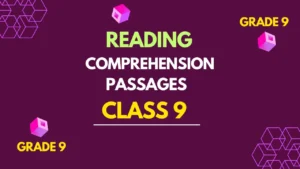
REPORTED SPEECH

Reported Statements
Here's how it works:
We use a 'reporting verb' like 'say' or 'tell'. ( Click here for more about using 'say' and 'tell' .) If this verb is in the present tense, it's easy. We just put 'she says' and then the sentence:
- Direct speech: I like ice cream.
- Reported speech: She says (that) she likes ice cream.
We don't need to change the tense, though probably we do need to change the 'person' from 'I' to 'she', for example. We also may need to change words like 'my' and 'your'. (As I'm sure you know, often, we can choose if we want to use 'that' or not in English. I've put it in brackets () to show that it's optional. It's exactly the same if you use 'that' or if you don't use 'that'.)
But , if the reporting verb is in the past tense, then usually we change the tenses in the reported speech:
- Reported speech: She said (that) she liked ice cream.
* doesn't change.
- Direct speech: The sky is blue.
- Reported speech: She said (that) the sky is/was blue.
Click here for a mixed tense exercise about practise reported statements. Click here for a list of all the reported speech exercises.
Reported Questions
So now you have no problem with making reported speech from positive and negative sentences. But how about questions?
- Direct speech: Where do you live?
- Reported speech: She asked me where I lived.
- Direct speech: Where is Julie?
- Reported speech: She asked me where Julie was.
- Direct speech: Do you like chocolate?
- Reported speech: She asked me if I liked chocolate.
Click here to practise reported 'wh' questions. Click here to practise reported 'yes / no' questions. Reported Requests
There's more! What if someone asks you to do something (in a polite way)? For example:
- Direct speech: Close the window, please
- Or: Could you close the window please?
- Or: Would you mind closing the window please?
- Reported speech: She asked me to close the window.
- Direct speech: Please don't be late.
- Reported speech: She asked us not to be late.
Reported Orders
- Direct speech: Sit down!
- Reported speech: She told me to sit down.
- Click here for an exercise to practise reported requests and orders.
- Click here for an exercise about using 'say' and 'tell'.
- Click here for a list of all the reported speech exercises.
DO YOU WANT TO MASTER ENGLISH GRAMMAR?
Your logical way to teach is very easy to understand.
This is the best-structured and the most clear course I've ever seen.
It was easy to learn - you explained it perfectly.
Reported Speech (Indirect Speech) in English – Summary
How to use reported speech.
If you have a sentence in Direct Speech, try to follow our 5 steps to put the sentence into Reported Speech..
- Define the type of the sentence (statement, questions, command)
- What tense is used in the introductory sentence?
- Do you have to change the person (pronoun)?
- Do you have to backshift the tenses?
- Do you have to change expressions of time and place?
1. Statements, Questions, Commands
Mind the type of sentences when you use Reported Speech. There is more detailed information on the following pages.
- Commands, Requests
2. The introductory sentence
If you use Reported Speech there are mostly two main differences.
The introductory sentence in Reported Speech can be in the Present or in the Past .
If the introductory sentences is in the Simple Present, there is no backshift of tenses.
Direct Speech:
- Susan, “ Mary work s in an office.”
Reported Speech:
- Introductory sentence in the Simple Present → Susan says (that)* Mary work s in an office.
- Introductory sentence in the Simple Past → Susan said (that)* Mary work ed in an office.
3. Change of persons/pronouns
If there is a pronoun in Direct Speech, it has possibly to be changed in Reported Speech, depending on the siutation.
- Direct Speech → Susan, “I work in an office.”
- Reported Speech → Susan said (that)* she worked in an office.
Here I is changed to she .
4. Backshift of tenses
If there is backshift of tenses in Reported Speech, the tenses are shifted the following way.
- Direct Speech → Peter, “ I work in the garden.”
- Reported Speech → Peter said (that)* he work ed in the garden.
5. Conversion of expressions of time and place
If there is an expression of time/place in the sentence, it may be changed, depending on the situation.
- Direct Speech → Peter, “I worked in the garden yesterday .”
- Reported Speech → Peter said (that) he had worked in the garden the day before .
6. Additional information
In some cases backshift of tenses is not necessary, e.g. when statements are still true. Backshift of tenses is never wrong.
- John, “My brother is at Leipzig university.”
- John said (that) his brother was at Leipzig university. or
- John said (that) his brother is at Leipzig university.
when you use general statements.
- Mandy, “The sun rises in the east.”
- Mandy said (that) the sun rose in the east. or
- Mandy said (that) the sun rises in the east.
* The word that is optional, that is the reason why we put it in brackets.
- You are here:
- Grammar Explanations
- Reported Speech

The Reported Speech
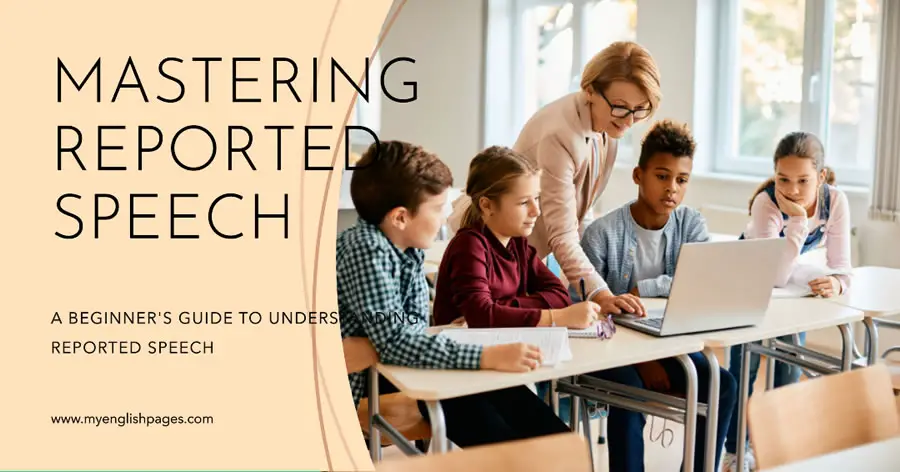
Table of Contents
What is reported speech.
Reported speech is when you tell somebody what you or another person said before. When reporting a speech, some changes are necessary.
For example, the statement:
- Jane said she was waiting for her mom .
is a reported speech, whereas:
- Jane said, “I’m waiting for my mom.”
is a direct speech.
Reported speech is also referred to as indirect speech or indirect discourse .
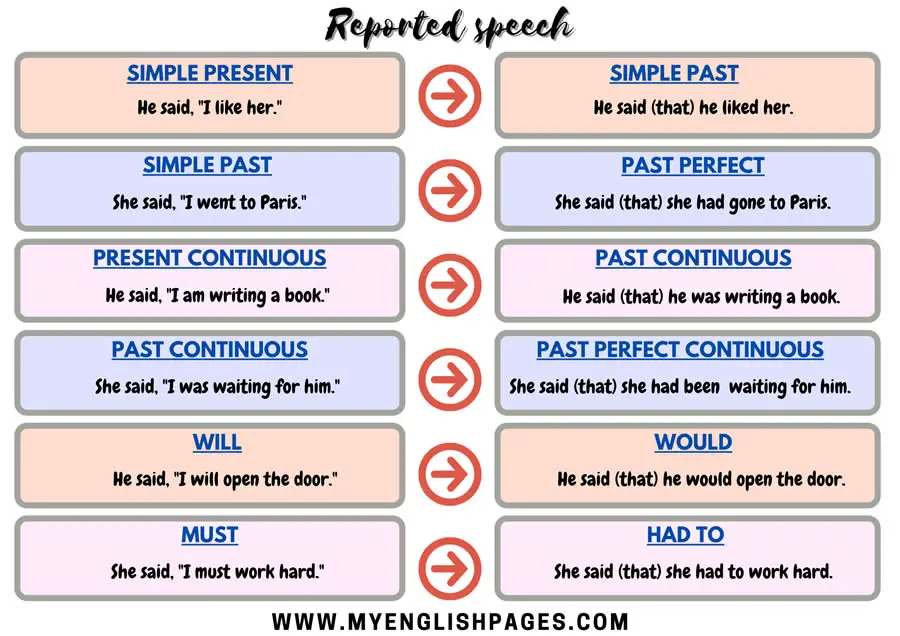
Before explaining how to report a discourse, let us first distinguish between direct speech and reported speech .
Direct speech vs reported speech
1. We use direct speech to quote a speaker’s exact words. We put their words within quotation marks. We add a reporting verb such as “he said” or “she asked” before or after the quote.
- He said, “I am happy.”
2. Reported speech is a way of reporting what someone said without using quotation marks. We do not necessarily report the speaker”‘s exact words. Some changes are necessary: the time expressions, the tense of the verbs, and the demonstratives.
- He said that he was happy.
More examples:
Different types of reported speech
When you use reported speech, you either report:
- Requests/commands
- Other types
A. Reporting statements
When transforming statements, check whether you have to change:
- place and time expression
1- Pronouns
In reported speech, you often have to change the pronoun depending on who says what.
She says, “My dad likes roast chicken.” => She says that her dad likes roast chicken.
- If the sentence starts in the present, there is no backshift of tenses in reported speech.
- If the sentence starts in the past, there is often a backshift of tenses in reported speech.
No backshift
Do not change the tense if the introductory clause (i.e., the reporting verb) is in the present tense (e. g. He says ). Note, however, that you might have to change the form of the present tense verb (3rd person singular).
- He says, “I write poems.” => He says that he writes English.
You must change the tense if the introductory clause (i.e., the reporting verb) is in the past tense (e. g. He said ).
- He said, “I am happy.”=> He said that he was happy.
Examples of the main changes in verb tense :
3. Modal verbs
The modal verbs could, should, would, might, needn’t, ought to, and used to do not normally change.
- He said: “She might be right.” => He said that she might be right.
- He told her: “You needn’t see a doctor.” => He told her that she needn’t see a doctor.
Other modal verbs such as can, shall, will, must, and ma y change:
4- Place, demonstratives, and time expressions
Place, demonstratives, and time expressions change if the context of the reported statement (i.e. the location and/or the period of time) is different from that of the direct speech.
In the following table, you will find the different changes of place; demonstratives, and time expressions.
B. Reporting Questions
When transforming questions, check whether you have to change:
- The pronouns
- The place and time expressions
- The tenses (backshift)
Also, note that you have to:
- transform the question into an indirect question
- use the question word ( where, when, what, how ) or if / whether
>> EXERCISE ON REPORTING QUESTIONS <<
C. Reporting requests/commands
When transforming requests and commands, check whether you have to change:
- place and time expressions
- She said, “Sit down.” – She asked me to sit down.
- She said, “don’t be lazy” – She asked me not to be lazy
D. Other transformations
- Expressions of advice with must , should, and ought are usually reported using advise / urge . Example: “You must read this book.” He advised/urged me to read that book.
- The expression let’s is usually reported using suggest . In this case, there are two possibilities for reported speech: gerund or statement with should . Example : “Let’s go to the cinema.” 1. He suggested going to the cinema. 2. He suggested that we should go to the cinema.
Main clauses connected with and/but
If two complete main clauses are connected with and or but , put that after the conjunction.
- He said, “I saw her but she didn’t see me.=> He said that he had seen her but that she hadn’t seen him.
If the subject is dropped in the second main clause (the conjunction is followed by a verb), do not use that .
- She said, “I am a nurse and work in a hospital.=> He said that she was a nurse and worked in a hospital.
punctuation rules of the reported speech
Direct speech:
We normally add a comma between the reporting verbs (e.g., she/he said, reported, he replied, etc.) and the reported clause in direct speech. The original speaker”s words are put between inverted commas, either single (“…”) or double (“…”).
- She said, “I wasn’t ready for the competition”.
Note that we insert the comma within the inverted commas if the reported clause comes first:
- “I wasn’t ready for the competition,” she said.
Indirect speech:
In indirect speech, we don’t put a comma between the reporting verb and the reported clause and we omit the inverted quotes.
- She said that she hadn’t been ready for the competition.
In reported questions and exclamations, we remove the question mark and the exclamation mark.
- She asked him why he looked sad?
- She asked him why he looked sad.
Can we omit that in the reported speech?
Yes, we can omit that after reporting verbs such as he said , he replied , she suggested , etc.
- He said that he could do it. – He said he could do it.
- She replied that she was fed up with his misbehavior. – She replied she was fed up with his misbehavior.
List of reporting verbs
Reported speech requires a reporting verb such as “he said”, she “replied”, etc.
Here is a list of some common reporting verbs:
- Cry (meaning shout)
- Demonstrate
- Hypothesize
- Posit the view that
- Question the view that
- Want to know
In reported speech, we put the words of a speaker in a subordinate clause introduced by a reporting verb such as – “ he said ” and “ she asked “- with the required person and tense adjustments.
Related pages
- Reported speech exercise (mixed)
- Reported speech exercise (questions)
- Reported speech exercise (requests and commands)
- Reported speech lesson
Reported Speech (Indirect Speech)
Exercises on reported speech.
If we report what another person has said, we usually do not use the speaker’s exact words (direct speech), but reported (indirect) speech. Therefore, you need to learn how to transform direct speech into reported speech. The structure is a little different depending on whether you want to transform a statement, question or request.
When transforming statements, check whether you have to change:
- present tense verbs (3rd person singular)
- place and time expressions
- tenses (backshift)
→ more on statements in reported speech
When transforming questions, check whether you have to change:
Also note that you have to:
- transform the question into an indirect question
- use the interrogative or if / whether
→ more on questions in reported speech
→ more on requests in reported speech
Additional Information and Exeptions
Apart from the above mentioned basic rules, there are further aspects that you should keep in mind, for example:
- main clauses connected with and / but
- tense of the introductory clause
- reported speech for difficult tenses
- exeptions for backshift
- requests with must , should , ought to and let’s
→ more on additional information and exeptions in reported speech
Statements in Reported Speech
- no backshift – change of pronouns
- no backshift – change of pronouns and places
- with backshift
- with backshift and change of place and time expressions
Questions in Reported Speech
Requests in reported speech.
- Exercise 1 – requests (positive)
- Exercise 2 – requests (negative)
- Exercise 3 – requests (mixed)
Mixed Exercises on Reported Speech
- Exercise on reported speech with and without backshift
Grammar in Texts
- „ The Canterville Ghost “ (highlight direct speech and reported speech)
My English Grammar
Ultimate English Grammar, Vocabulary, and Names Database
Indirect Speech or Reported Speech
Introduction to indirect speech or reported speech.
Speech, in English Grammar, is categorized into two types – Direct Speech and Indirect Speech or Reported Speech. This tutorial gives a detailed overview of Indirect or Reported Speech. This particular form of speech is used when we convey or report what someone else has said, but not using their exact words.
Table of Contents
Understanding Indirect Speech
In Indirect Speech, the message of the speaker is expressed in our words. Therefore, the sentences are not enclosed in quotation marks. It is mostly used in writing, where the phrases and clauses are typically in the past tense because they’re reporting something that has already happened. However, changes may be necessary based on the situation and verb tenses.
- Direct: James said, “I am going to the movies.”
- Indirect: James said that he was going to the movies.
- Direct: She said, “I am reading a book.”
- Indirect: She said that she was reading a book.
Changing from Direct to Indirect Speech
When changing direct speech into indirect speech, certain changes are necessary. Here are the basic rules to be followed:
In general, the tense of the verb in direct speech has to be changed into the past tense in reported speech. Here are some examples:
- Present Simple changes to Past Simple.
- Present Continuous changes to Past Continuous.
- Present Perfect changes to Past Perfect.
Change of person in reported speech is necessary in accordance with the rules of sequence of pronouns depending upon the person of the reporting verb and that of the reported speech. The 1st person of reported speech changes as per the subject of the reporting verb and the 2nd person changes as per the object of the reporting verb. For example:
- He said, “I am not guilty.” (Direct)
- He said that he was not guilty. (Indirect)
Changing Time References
In reported speech, we often have to shift expressions of time to match the moment of speaking. For example:
- Direct: “I’m coming tomorrow,” he said.
- Indirect: He said that he was coming the next day.
Changing Modals
In the case of verbs that contain modals, some changes might be necessary:
- Can changes to could.
- May changes to might.
- Must, Will change to would.
Changing Place References
Similar to time references, place references may need to change:
- Direct: “Meet me here,” she said.
- Indirect: She asked me to meet her there.
Assertive Sentences
When the reported speech is an assertive sentence without modals, the reporting verb “said” can be used with ‘that’-
- Direct: He said, “I was ill.”
- Indirect: He said that he had been ill.
Interrogative Sentences
When the reported speech is an interrogative sentence, the reporting verb “said” changes to some verb denoting interrogation, i.e., asked, inquired etc. For example:
- Direct: He said, “Have you finished your assignment?”
- Indirect: He asked if I had finished my assignment.
Imperative Sentences
When the reported speech is an imperative sentence, we use ‘Ordered/requested/suggested’ etc. instead of ‘said’ as reporting verb along with the conjunctions ‘to/not to’. For example:
- Direct: He said, “Open the gate.”
- Indirect: He told me to open the gate.
Exclamatory Sentences
When the reported speech is an exclamatory sentence, the reported speech shows some sudden feeling and uses ‘Exclaimed with joy/sorrow/wonder’ as a reporting verb. For example:
- Direct: He said, “Hurrah! We have won the match.”
- Indirect: He exclaimed with joy that they had won the match.
Indirect or Reported Speech presents past statements or questions that are reported or retold to someone else. Recognizing and understanding the changes that happens when direct speech is transferred into indirect speech such as verb tenses, time and place references, modal usage, pronouns, etc. allows you to write and communicate more effectively and precisely.
Related Posts:

Leave a Reply Cancel reply
You must be logged in to post a comment.

Direct Speech and Indirect Speech (Reported Speech)
- August 30, 2023
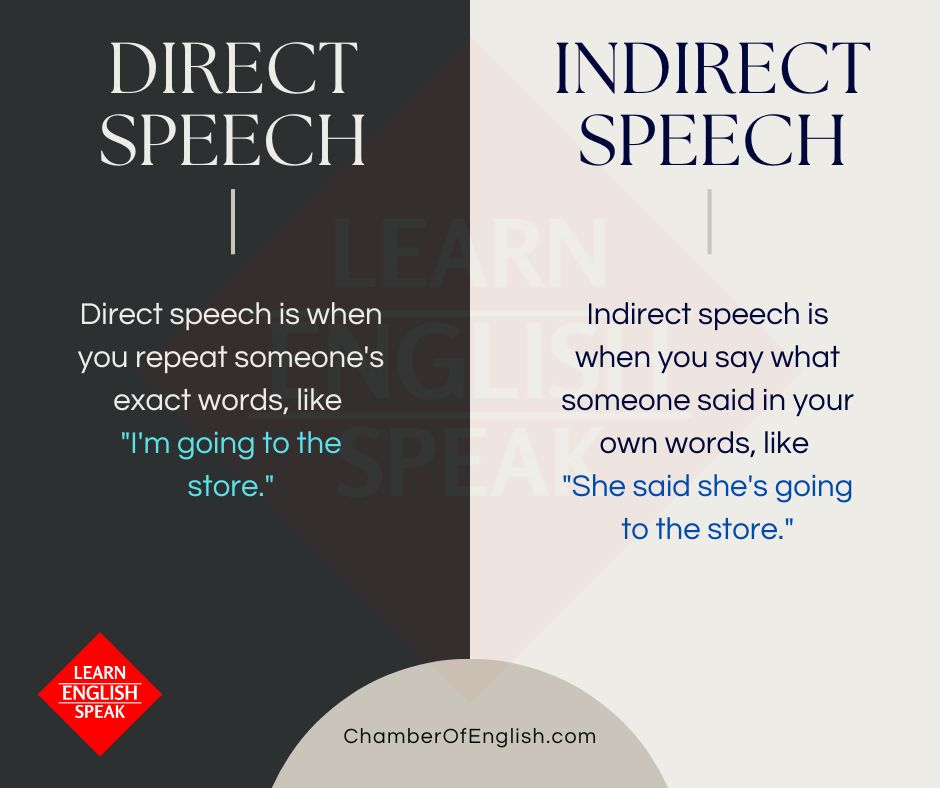
Direct speech is when you repeat someone’s exact words, like “I’m going to the store.”
Indirect speech is when you say what someone said in your own words, like “She said she’s going to the store.”
So, direct speech uses the exact words, while indirect speech rephrases what was said. Remember, in indirect speech, things like tenses, pronouns, and time expressions might change to fit the new sentence.
A. Changes in Tenses and Passive Voice in Reported Speech
Reported speech, also known as indirect speech, requires us to convey the words spoken by someone else while adapting them to a new context. This often involves changes in tenses and passive voice to accurately represent the original message. Let’s explore how different tenses and passive voice transform in reported speech, along with examples for each:
- Direct Speech: “I eat an apple.”
- Reported Speech: He said that he ate an apple.
- Direct Speech: “She is reading a book.”
- Reported Speech: She said that she was reading a book.
- Direct Speech: “They visited the museum.”
- Reported Speech: They said that they visited the museum.
- Direct Speech: “I was playing tennis.”
- Reported Speech: He said that he had been playing tennis.
- Direct Speech: “She had finished her work.”
- Reported Speech: She said that she had finished her work.
- Direct Speech: “They had been studying for hours.”
- Reported Speech: They said that they had been studying for hours.
- Direct Speech: “I have seen that movie.”
- Reported Speech: She said that she had seen that movie.
- Direct Speech: “He has been working all day.”
- Reported Speech: He said that he had been working all day.
- Direct Speech: “I will come tomorrow.”
- Reported Speech: She said that she would come the next day.
- Direct Speech: “They will have finished by then.”
- Reported Speech: They said that they would have finished by then.
- Direct Speech: “The book is read by her.”
- Reported Speech: She said that the book was read by her.
- Direct Speech: “The cake is being baked.”
- Reported Speech: They said that the cake was being baked.
Remember that when transforming tenses and passive voice in reported speech, the changes depend on the context and the tense of the original statement. Adapting these changes correctly ensures that the essence of the original message is conveyed accurately in the reported speech.
B. Changes in Pronouns in Reported Speech
Reported speech, also known as indirect speech, involves relaying someone else’s words while adapting them to a new context. Pronouns play a crucial role in this transformation, as they need adjustments to match the perspective of the reporting speaker. Here’s a brief overview of how pronouns change in reported speech:
Changing Pronouns:
Pronouns in reported speech often change to reflect the perspective of the reporting speaker or the listener.
- Direct Speech: “I am reading a book.”
- Reported Speech: She said that she is reading a book.
First Person to Third Person:
Pronouns shift from the first person to the third person in reported speech.
- Reported Speech: He said that he would come the next day.
Second Person to Third Person:
Pronouns shift from the second person to the third person in reported speech.
- Direct Speech: “You should call your parents.”
- Reported Speech: He said that I should call my parents.
Third Person to Third Person:
When the original and reported speeches are both in the third person, there’s often no change in pronouns.
- Direct Speech: “She mentioned visiting the museum.”
- Reported Speech: She mentioned visiting the museum.
Possessive Pronouns:
Possessive pronouns also shift according to the reporting speaker’s perspective.
- Direct Speech: “This is my book.”
- Reported Speech: He said that it was his book.
Maintaining Consistency:
Pronouns maintain consistency throughout the reported speech.
- Direct Speech: “He called and said, ‘I will be there.'”
- Reported Speech: He called and said that he would be there.
Adapting Demonstrative Pronouns:
Demonstrative pronouns may change based on the context of the reported speech.
- Direct Speech: “Take this one.”
- Reported Speech: She told me to take that one.
Changing Reflexive Pronouns:
Reflexive pronouns shift as needed to align with the new subject.
- Direct Speech: “She washed herself.”
- Reported Speech: He said that she washed herself.
Adjusting Indirect Object Pronouns:
Indirect object pronouns may require changes based on the reporting context.
- Direct Speech: “He gave me a gift.”
- Reported Speech: She mentioned that he had given her a gift.
C. Changes in Modals in Reported Speech
- In reported speech, ‘can’ generally changes to ‘could.’
- Direct Speech: “I can swim.”
- Reported Speech: She said that she could swim.
- The modal ‘may’ typically changes to ‘might’ in reported speech.
- Direct Speech: “I may go to the party.”
- Reported Speech: He said that he might go to the party.
- ‘Must’ remains ‘must’ in reported speech, but the context of necessity may change.
- Direct Speech: “I must finish the assignment.”
- Reported Speech: She said that she must finish the assignment.
- ‘Should’ can either remain ‘should’ or change to ‘ought to’ in reported speech.
- Direct Speech: “You should exercise regularly.”
- Reported Speech: He said that I should/ought to exercise regularly.
- ‘Will’ often changes to ‘would’ in reported speech to indicate future possibilities.
- Direct Speech: “I will help you.”
- Reported Speech: She said that she would help me.
- ‘Shall’ can change to ‘should’ or ‘would’ in reported speech, depending on the context.
- Direct Speech: “Shall I open the window?”
- Reported Speech: She asked if she should open the window.
- In reported speech, ‘can’ changes to ‘could’ to maintain politeness.
- Direct Speech: “Can you please pass the salt?”
- Reported Speech: He asked if I could pass the salt.
- ‘Must’ can change to ‘had to’ in reported speech to reflect necessity.
- Direct Speech: “You must attend the meeting.”
- Reported Speech: She said that I had to attend the meeting.
- ‘Will’ can change to ‘was/were going to’ in reported speech for planned actions.
- Direct Speech: “I will visit the museum.”
- Reported Speech: He said that he was going to visit the museum.
- ‘Can’t’ changes to ‘couldn’t’ in reported speech to reflect inability.
- Direct Speech: “I can’t solve this puzzle.”
- Reported Speech: She said that she couldn’t solve the puzzle.
- ‘Should’ can change to ‘ought to’ in reported speech to maintain formality.
- Reported Speech: He said that I ought to call my parents.
- ‘May’ can change to ‘might’ in reported speech for polite requests.
- Direct Speech: “May I borrow your pen, please?”
- Reported Speech: She asked if she might borrow my pen.
In reported speech, modals often undergo changes to suit the indirect context while retaining the original meaning. The transformation of modals contributes to accurate and effective communication when conveying someone else’s words and intentions.
D. Changes in Place References in Reported Speech
Place references are an important aspect of reported speech, requiring adjustments to accurately convey the speaker’s intended location. Let’s explore how place references change in reported speech, along with examples for each scenario:
- Direct Speech: “I live here.”
- Reported Speech: She said that she lived there.
- Direct Speech: “Take this book.”
- Reported Speech: He told me to take that book.
- Direct Speech: “She mentioned visiting the Eiffel Tower.”
- Reported Speech: She mentioned visiting the Eiffel Tower.
- Direct Speech: “Pass me that book.”
- Reported Speech: He asked me to pass him that book.
- Direct Speech: “Where is the nearest café?”
- Reported Speech: She asked where the nearest café was.
- Direct Speech: “He said, ‘Come here.'”
- Reported Speech: He told me to go there.
- Direct Speech: “I found the key under the mat.”
- Reported Speech: She said she had found the key under the mat.
- Direct Speech: “He lives near the park.”
- Reported Speech: He said he lived near the park.
- Direct Speech: “She lives in New York.”
- Reported Speech: He mentioned that she lived in New York.
- Direct Speech: “Give me this one.”
- Reported Speech: He asked for that one.
Adapting place references accurately ensures that the location and context of the original conversation are effectively maintained, even when narrated indirectly.
E. Changes in Questions in Reported Speech
Questions, both “Yes/No questions” and “Wh-questions,” undergo specific changes when reported. These changes ensure that the reported speech accurately captures the essence of the original question. Here’s an exploration of how different types of questions change in reported speech, accompanied by examples:
- Direct Speech: “Did you finish your homework?”
- Reported Speech: She asked if I had finished my homework.
- Direct Speech: “Yes, I did finish my homework,” he said.
- Reported Speech: He said that he had finished his homework.
- Direct Speech: “Where are you going?”
- Reported Speech: He asked where I was going.
- Direct Speech: “I am going to the park,” she replied.
- Reported Speech: She replied that she was going to the park.
- Direct Speech: “What time does the train arrive?”
- Reported Speech: He wanted to know what time the train arrived.
- Direct Speech: “Is she coming to the party?”
- Reported Speech: He asked if she was coming to the party.
- Direct Speech: “When will the meeting start?”
- Reported Speech: She wondered when the meeting would start.
- Direct Speech: “Could you please pass me the salt?”
- Reported Speech: She asked if I could pass her the salt.
- Direct Speech: “Can you help me?”
- Reported Speech: He asked if I could help him.
- Direct Speech: “Why did you do that?”
- Reported Speech: She demanded to know why I had done that.
Mastering the changes in reported speech for both yes/no and wh-questions is essential for accurately conveying conversations while adapting them to different linguistic contexts. These transformations ensure that the nuances of questions are maintained even when relayed indirectly.
F. Converting Time References in Reported Speech
Adapting time references is crucial in reported speech to ensure accurate conveyance of the original message. Time expressions such as “today,” “tomorrow,” “now,” “last week,” “last night,” “yesterday,” “days ago,” and “ago” require specific changes in reported speech to reflect the shift in time. Here’s a guide on how to convert sentences with time references to reported speech:
- Direct Speech: “I am busy today.”
- Reported Speech: She said that she was busy that day.
- Direct Speech: “I am studying now.”
- Reported Speech: He said that he was studying then.
- Direct Speech: “I went to the market yesterday.”
- Reported Speech: She said that she had gone to the market the previous day.
- Direct Speech: “He visited last week, a few days ago.”
- Reported Speech: They mentioned that he had visited the previous week, a few days before.
- Direct Speech: “She called me last week.”
- Reported Speech: He said that she had called him the previous week.
- Direct Speech: “We had dinner together last night.”
- Reported Speech: They mentioned that they had dinner together the previous night.
- Direct Speech: “I am the current manager.”
- Reported Speech: She said that she is the current manager.
- Direct Speech: “I will meet you tomorrow.”
- Reported Speech: He said that he would meet me the next day.
- Direct Speech: “They plan to travel next week.”
- Reported Speech: She mentioned that they planned to travel the following week.
Adapting time references in reported speech is essential to ensure that the context and timing of the original message are accurately conveyed, even when the conversation is relayed indirectly.
G. Changes in Commands in Reported Speech
Reporting commands requires particular adjustments to accurately represent the original instruction. Here’s a concise guide on how commands change in reported speech:
- In direct commands, the verb is typically in the imperative form.
- Direct Speech: “Open the window.”
- Reported Speech: He told me to open the window.
- In reported speech, the command changes to a verb of reporting, followed by an infinitive form.
- Direct Speech: “Clean your room.”
- Reported Speech: She asked me to clean my room.
- Pronouns in commands may need to be adjusted to match the new context.
- Direct Speech: “Take your umbrella.”
- Reported Speech: He told me to take my umbrella.
- Modals can be used to soften the command’s tone in reported speech.
- Direct Speech: “Give me the book.”
- Reported Speech: She requested me to give her the book.
- Reporting verbs like “tell,” “ask,” “request,” “command,” or “order” are used to introduce the reported command.
- Direct Speech: “Do your homework.”
- Reported Speech: He ordered me to do my homework.
- Time references may need to be adapted in reported commands.
- Direct Speech: “Call me later.”
- Reported Speech: She asked me to call her later.
- Polite commands remain polite in reported speech.
- A direct command changes to an indirect request.
- Direct Speech: “Shut the door.”
- Reported Speech: He asked me to shut the door.
Mastering the changes in reported speech for commands is essential for accurately conveying instructions while adapting them to different linguistic contexts. These transformations ensure that the nuances of commands are maintained even when relayed indirectly.
Stay tuned for more engaging lessons on grammar and follow us on our Facebook page: Learn English – Speak English
Recent Posts:

Verbs – Introduction

Subject-Verb Agreement
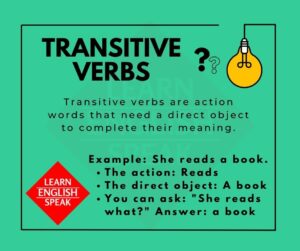
Transitive Verbs

IMAGES
COMMENTS
Reported speech: indirect speech - English Grammar Today - a reference to written and spoken English grammar and usage - Cambridge Dictionary
Pronoun changes in indirect speech In reported or indirect speech, we must also pay attention to the use of pronouns. When a person tells us something, he or she uses the first person ( I, me, my, we, us, our ) to talk about himself or herself and the second person ( you, your ) to talk about us, the person listening.
Oct 30, 2024 · Key Characteristics of Indirect Speech No Quotation Marks Are Used. Unlike direct speech, indirect speech does not use quotation marks. Instead, it embeds the reported statement within a sentence using a conjunction like “that” or phrases such as “if” or “whether” for reported questions. Direct Speech: Sarah said, “I am happy.”
Aug 22, 2024 · When introducing indirect speech with a reporting verb, use a comma to separate the reporting verb from the reported speech. Example: She said, “I’ll be there on time.” Rule 11: Direct and Indirect Speech Rules for Question Mark to Full Stop
Time Expressions with Reported Speech Sometimes when we change direct speech into reported speech we have to change time expressions too. We don't always have to do this, however. It depends on when we heard the direct speech and when we say the reported speech. For example: It's Monday. Julie says "I'm leaving today".
Reported Speech → Susan said (that)* she worked in an office. Here I is changed to she. 4. Backshift of tenses. If there is backshift of tenses in Reported Speech, the tenses are shifted the following way. Direct Speech → Peter, “ I work in the garden.” Reported Speech → Peter said (that)* he work ed in the garden.
Before explaining how to report a discourse, let us first distinguish between direct speech and reported speech. Direct speech vs reported speech. 1. We use direct speech to quote a speaker’s exact words. We put their words within quotation marks. We add a reporting verb such as “he said” or “she asked” before or after the quote. Example:
Exercises on Reported Speech. If we report what another person has said, we usually do not use the speaker’s exact words (direct speech), but reported (indirect) speech. Therefore, you need to learn how to transform direct speech into reported speech.
Indirect or Reported Speech presents past statements or questions that are reported or retold to someone else. Recognizing and understanding the changes that happens when direct speech is transferred into indirect speech such as verb tenses, time and place references, modal usage, pronouns, etc. allows you to write and communicate more ...
Aug 30, 2023 · A. Changes in Tenses and Passive Voice in Reported Speech. Reported speech, also known as indirect speech, requires us to convey the words spoken by someone else while adapting them to a new context. This often involves changes in tenses and passive voice to accurately represent the original message.